Life Cycle Assessment of Sugar Palm Fiber Reinforced-Sago Biopolymer Composite Takeout Food Container
Abstract
1. Introduction
2. Methodology
2.1. Goal, Scope, and Functional Unit of the Study
2.2. Data and Data Quality Requirements (Sources and Geography)
2.2.1. Production Processes
2.2.2. Consumption Stage
2.2.3. Distances and Transportation
2.2.4. End-Of-Life Stages
2.3. Life Cycle Impact Assessment (LCIA)
3. Results and Discussion
4. Conclusions
Author Contributions
Funding
Acknowledgments
Conflicts of Interest
References
- Geyer, R.; Jambeck, J.R.; Law, K.L. Production, uses, and fate of all plastics ever made. Sci. Adv. 2017, 3, 5. [Google Scholar] [CrossRef] [PubMed]
- Ellen MacArthur Foundation and McKinsey & Company. The New Plastics Economy: Rethinking the Future of Plastics; World Economic Forum: Geneva, Switzerland, 2016. [Google Scholar]
- Li, W.C.; Tse, H.F.; Fok, L. Plastic waste in the marine environment: A review of sources, occurrence and effects. Sci. Total Environ. 2016, 566–567, 333–349. [Google Scholar] [CrossRef] [PubMed]
- Karpušenkaitė, A.; Varžinskas, V. Bioplastics: Development, Possibilities and Difficulties. Environ. Res. Eng. Manag. 2014. [Google Scholar] [CrossRef]
- Madival, S.; Auras, R.; Singh, S.P.; Narayan, R. Assessment of the environmental profile of PLA, PET and PS clamshell containers using LCA methodology. J. Clean. Prod. 2009, 17, 1183–1194. [Google Scholar] [CrossRef]
- Venkatachalam, V.; Spierling, S.; Horn, R.; Endres, H.J. LCA and Eco-design: Consequential and Attributional Approaches for Bio-based Plastics. Procedia CIRP 2018, 69, 579–584. [Google Scholar] [CrossRef]
- Günkaya, Z.; Banar, M. An environmental comparison of biocomposite film based on orange peel-derived pectin jelly-corn starch and LDPE film: LCA and biodegradability. Int. J. Life Cycle Assess. 2016, 21, 465–475. [Google Scholar] [CrossRef]
- Hottle, T.A.; Bilec, M.M.; Landis, A.E. Biopolymer production and end of life comparisons using life cycle assessment. Resour. Conserv. Recycl. 2017. [Google Scholar] [CrossRef]
- Maga, D.; Hiebel, M.; Aryan, V. A comparative life cycle assessment of meat trays made of various packaging materials. Sustainability 2019, 11, 5324. [Google Scholar] [CrossRef]
- Petrucci, R.; Fortunati, E.; Puglia, D.; Luzi, F.; Kenny, J.M.; Torre, L. Life Cycle Analysis of Extruded Films Based on Poly(lactic acid)/Cellulose Nanocrystal/Limonene: A Comparative Study with ATBC Plasticized PLA/OMMT Systems. J. Polym. Environ. 2018. [Google Scholar] [CrossRef]
- Ingrao, C.; Gigli, M.; Siracusa, V. An attributional Life Cycle Assessment application experience to highlight environmental hotspots in the production of foamy polylactic acid trays for fresh-food packaging usage. J. Clean. Prod. 2017, 150, 93–103. [Google Scholar] [CrossRef]
- Bernstad Saraiva, A.; Pacheco, E.B.A.V.; Gomes, G.M.; Visconte, L.L.Y.; Bernardo, C.A.; Simões, C.L.; Soares, A.G. Comparative lifecycle assessment of mango packaging made from a polyethylene/natural fiber-composite and from cardboard material. J. Clean. Prod. 2016. [Google Scholar] [CrossRef]
- Lorite, G.S.; Rocha, J.M.; Miilumäki, N.; Saavalainen, P.; Selkälä, T.; Morales-Cid, G.; Gonçalves, M.P.; Pongrácz, E.; Rocha, C.M.R.; Toth, G. Evaluation of physicochemical/microbial properties and life cycle assessment (LCA) of PLA-based nanocomposite active packaging. LWT Food Sci. Technol. 2017, 75, 305–315. [Google Scholar] [CrossRef]
- Barros, M.V.; Salvador, R.; Piekarski, C.M.; de Francisco, A.C. Mapping of main research lines concerning life cycle studies on packaging systems in Brazil and in the world. Int. J. Life Cycle Assess. 2019, 24, 1429–1443. [Google Scholar] [CrossRef]
- Salwa, H.N.; Sapuan, S.M.; Mastura, M.T.; Zuhri, M.Y.M. Analytic Hierarchy Process (AHP)-based materials selection system for natural fiber as reinforcement in biopolymer composites for food packaging. BioResources 2019. [Google Scholar] [CrossRef]
- Salwa, H.N.; Sapuan, S.M.; Mastura, M.T.; Zuhri, M.Y.M. Application of Shannon’s Entropy-Analytic Hierarchy Process (AHP) for the Selection of the Most Suitable Starch as Matrix in Green Biocomposites for Takeout Food Packaging Design. BioResources 2019, 15, 4065–4088. [Google Scholar]
- ISO 14040 The International Standards Organisation. Environmental management—Life cycle assessment—Principles and Framework. ISO 14040. 2006. Available online: https://www.iso.org/standard/37456.html (accessed on 28 October 2020).
- Ingrao, C.; Lo Giudice, A.; Bacenetti, J.; Mousavi Khaneghah, A.; de Sant’Ana, A.S.; Rana, R.; Siracusa, V. Foamy polystyrene trays for fresh-meat packaging: Life-cycle inventory data collection and environmental impact assessment. Food Res. Int. 2015, 76, 418–426. [Google Scholar] [CrossRef]
- PRé Consultants. SimaPro|The World’s Leading LCA Software; PRé Consultants: Amersfoort, The Netherlands, 2019. [Google Scholar]
- Bohlmann, G.M. Biodegradable packaging life-cycle assessment. Environ. Prog. 2004, 23, 342–346. [Google Scholar] [CrossRef]
- Vignali, G. Life-Cycle Assessment of Food-Packaging Systems. In Environmental Footprints and Eco-Design of Products and Processes; Muthu, S., Ed.; Springer: Singapore, 2016; pp. 1–22. [Google Scholar]
- Molina-Besch, K.; Wikström, F.; Williams, H. The environmental impact of packaging in food supply chains—does life cycle assessment of food provide the full picture? Int. J. Life Cycle Assess. 2019. [Google Scholar] [CrossRef]
- Yusuf, M.A.; Romli, M.; Suprihatin; Wiloso, E.I. Potential of Traditional Sago Starch: Life Cycle Assessment (LCA) Perspective. IOP Conf. Ser. Mater. Sci. Eng. 2019, 507, 012014. [Google Scholar] [CrossRef]
- Groot, W.J.; Borén, T. Life cycle assessment of the manufacture of lactide and PLA biopolymers from sugarcane in Thailand. Int. J. Life Cycle Assess. 2010. [Google Scholar] [CrossRef]
- Mahalle, L.; Alemdar, A.; Mihai, M.; Legros, N. A cradle-to-gate life cycle assessment of wood fibre-reinforced polylactic acid (PLA) and polylactic acid/thermoplastic starch (PLA/TPS) biocomposites. Int. J. Life Cycle Assess. 2014, 19, 1305–1315. [Google Scholar] [CrossRef]
- Lai, J.C.; Rahman, W.A.W.A.; Avérous, L.; Lim, T.H. Study and characterisation of the post processing ageing of sago pith waste biocomposites. Sains Malaysiana 2016, 45, 633–641. [Google Scholar]
- Huzaifah, M.R.M.; Sapuan, S.M.; Leman, Z.; Ishak, M.R. Comparative Study on Chemical Composition, Physical, Tensile, and Thermal Properties of Sugar Palm Fiber (Arenga pinnata) Obtained from Different Geographical Locations. Bioresources 2017, 12, 9366–9382. [Google Scholar] [CrossRef]
- Johari, A.; Alkali, H.; Hashim, H.; Ahmed, S.I.; Mat, R. Municipal Solid Waste Management and Potential Revenue from Recycling in Malaysia. Mod. Appl. Sci. 2014, 8, 37–49. [Google Scholar] [CrossRef]
- Khandelwal, H.; Thalla, A.K.; Kumar, S.; Kumar, R. Life cycle assessment of municipal solid waste management options for India. Bioresour. Technol. 2019, 288, 121515. [Google Scholar] [CrossRef] [PubMed]
- Karim, A.A.; Tie, A.P.; Manan, D.M.A.; Zaidul, I.S.M. Starch from the Sago (Metroxylon sagu) Palm TreeProperties, Prospects, and Challenges as a New Industrial Source for Food and Other Uses. Compr. Rev. Food Sci. Food Saf. 2008, 7, 215–228. [Google Scholar] [CrossRef]
- Sahari, J.; Sapuan, S.M.; Zainudin, E.S.; Maleque, M.A. Thermo-mechanical behaviors of thermoplastic starch derived from sugar palm tree (Arenga pinnata). Carbohydr. Polym. 2013, 92, 1711–1716. [Google Scholar] [CrossRef] [PubMed]
- Zuraida, A.; Anuar, H.; Yusof, Y. The Study of Biodegradable Thermoplastics Sago Starch. Key Eng. Mater. 2011, 471–472, 397–402. [Google Scholar] [CrossRef]
- Wan, Y.K.; Ng, R.T.L.; Ng, D.K.S.; Aviso, K.B.; Tan, R.R. Fuzzy multi-footprint optimisation (FMFO) for synthesis of a sustainable value chain: Malaysian sago industry. J. Clean. Prod. 2016, 128, 62–76. [Google Scholar] [CrossRef]
- Bare, J.C.; Hofstetter, P.; Pennington, D.W.; de Haes, H.A.U. Midpoints versus endpoints: The sacrifices and benefits. Int. J. Life Cycle Assess. 2000. [Google Scholar] [CrossRef]
- Khoshnava, S.M.; Rostami, R.; Ismail, M.; Rahmat, A.R. A cradle-to-gate based life cycle impact assessment comparing the KBFwEFB hybrid reinforced poly hydroxybutyrate biocomposite and common petroleum-based composites as building materials. Environ. Impact Assess. Rev. 2018, 70, 11–21. [Google Scholar] [CrossRef]
- Zhang, X.; Zhang, M.; Zhang, H.; Jiang, Z.; Liu, C.; Cai, W. A review on energy, environment and economic assessment in remanufacturing based on life cycle assessment method. J. Clean. Prod. 2020, 255, 120160. [Google Scholar] [CrossRef]
- Yusof, N.S.B.; Sapuan, S.M.; Sultan, M.T.; Jawaid, M. Life cycle analysis of hybrid oil palm/glass fibre-reinforced polyurethane composites for Automotive Crash Box. J. Mech. Eng. Sci. 2020, 14, 6393–6402. [Google Scholar] [CrossRef]
- Arnesen, T.; Kapiriri, L. Can the value choices in DALYs influence global priority-setting? Health Policy 2004, 70, 137–149. [Google Scholar] [CrossRef] [PubMed]
- Reidpath, D.D. Measuring health in a vacuum: Examining the disability weight of the DALY. Health Policy Plan. 2003, 18, 351–356. [Google Scholar] [CrossRef]
- Weiskopf, S.R.; Rubenstein, M.A.; Crozier, L.G.; Gaichas, S.; Griffis, R.; Halofsky, J.E.; Hyde, K.J.W.; Morelli, T.L.; Morisette, J.T.; Muñoz, R.C.; et al. Climate change effects on biodiversity, ecosystems, ecosystem services, and natural resource management in the United States. Sci. Total Environ. 2020, 18, 137782. [Google Scholar] [CrossRef]
- Lindley, S.J.; Cook, P.A.; Dennis, M.; Gilchrist, A. Biodiversity, Physical Health and Climate Change: A Synthesis of Recent Evidence. In Biodiversity and Health in the Face of Climate Change; Springer International Publishing: Cham, Switzerland, 2019; pp. 17–46. [Google Scholar]
- Okubo, M.; Kuwahara, T. Emission regulations. New Technologies for Emission Control in Marine Diesel Engines; Butterworth-Heinemann: Oxford, UK, 2020; pp. 25–51. [Google Scholar]
- Kampa, M.; Castanas, E. Human health effects of air pollution. Environ. Pollut. 2008. [Google Scholar] [CrossRef]
- Hertwich, E.G.; Mateles, S.F.; Pease, W.S.; McKone, T.E. Human toxicity potentials for life-cycle assessment and toxics release inventory risk screening. Environ. Toxicol. Chem. 2001, 20, 928–939. [Google Scholar] [CrossRef]
- Mazukhina, S.; Tereshchenko, P.; Drogobuzhskaya, S.; Pozhilenko, V. The speciation of chemical elements in water and their possible impact on human health. In Proceedings of the 16th International Symposium on Water-Rock Interaction (WRI-16) and 13th International Symposium on Applied Isotope Geochemistry (1st IAGC International Conference), Tomsk, Russia, 21–26 July 2019. [Google Scholar]
- Luderer, U.; Eskenazi, B.; Hauser, R.; Korach, K.S.; McHale, C.M.; Moran, F.; Rieswijk, L.; Solomon, G.; Udagawa, O.; Zhang, L.; et al. Proposed key characteristics of female reproductive toxicants as an approach for organizing and evaluating mechanistic data in hazard assessment. Environ. Health Perspect. 2019. [Google Scholar] [CrossRef]
- Barnes, P.W.; Williamson, C.E.; Lucas, R.M.; Robinson, S.A.; Madronich, S.; Paul, N.D.; Bornman, J.F.; Bais, A.F.; Sulzberger, B.; Wilson, S.R.; et al. Ozone depletion, ultraviolet radiation, climate change and prospects for a sustainable future. Nat. Sustain. 2019. [Google Scholar] [CrossRef]
- Tong, S.; Ebi, K. Preventing and mitigating health risks of climate change. Environ. Res. 2019. [Google Scholar] [CrossRef] [PubMed]
- Marselle, M.R.; Stadler, J.; Korn, H.; Irvine, K.N.; Bonn, A. Biodiversity and Health in the Face of Climate Change: Challenges, Opportunities and Evidence Gaps. In Biodiversity and Health in the Face of Climate Change; Springer International Publishing: Cham, Switzerland, 2019; pp. 1–13. [Google Scholar]
- Pecl, G.T.; Araújo, M.B.; Bell, J.D.; Blanchard, J.; Bonebrake, T.C.; Chen, I.C.; Clark, T.D.; Colwell, R.K.; Danielsen, F.; Evengård, B.; et al. Biodiversity redistribution under climate change: Impacts on ecosystems and human well-being. Science 2017, 1–13. [Google Scholar] [CrossRef] [PubMed]
- Patel, M.; Bastioli, C.; Marini, L.; Würdinger, E. Life-cycle Assessment of Bio-based Polymers and Natural Fiber Composites. Biopolym. Online 2003. [Google Scholar] [CrossRef]
- Peters, G.P.; Andrew, R.M.; Canadell, J.G.; Friedlingstein, P.; Jackson, R.B.; Korsbakken, J.I.; Le Quéré, C.; Peregon, A. Carbon dioxide emissions continue to grow amidst slowly emerging climate policies. Nat. Clim. Chang. 2020. [Google Scholar] [CrossRef]
- Müller-Wenk, R.; Brandão, M. Climatic impact of land use in LCA-carbon transfers between vegetation/soil and air. Int. J. Life Cycle Assess. 2010. [Google Scholar] [CrossRef]
- De Rosa, M. Land Use and Land-use Changes in Life Cycle Assessment: Green Modelling or Black Boxing? Ecol. Econ. 2018. [Google Scholar] [CrossRef]
- Haye, S.; Slaveykova, V.I.; Payet, J. Terrestrial ecotoxicity and effect factors of metals in life cycle assessment (LCA). Chemosphere 2007. [Google Scholar] [CrossRef] [PubMed]
- Tennøy, A.; Kværner, J.; Gjerstad, K.I. Uncertainty in environmental impact assessment predictions: The need for better communication and more transparency. Impact Assess. Proj. Apprais. 2006. [Google Scholar] [CrossRef]
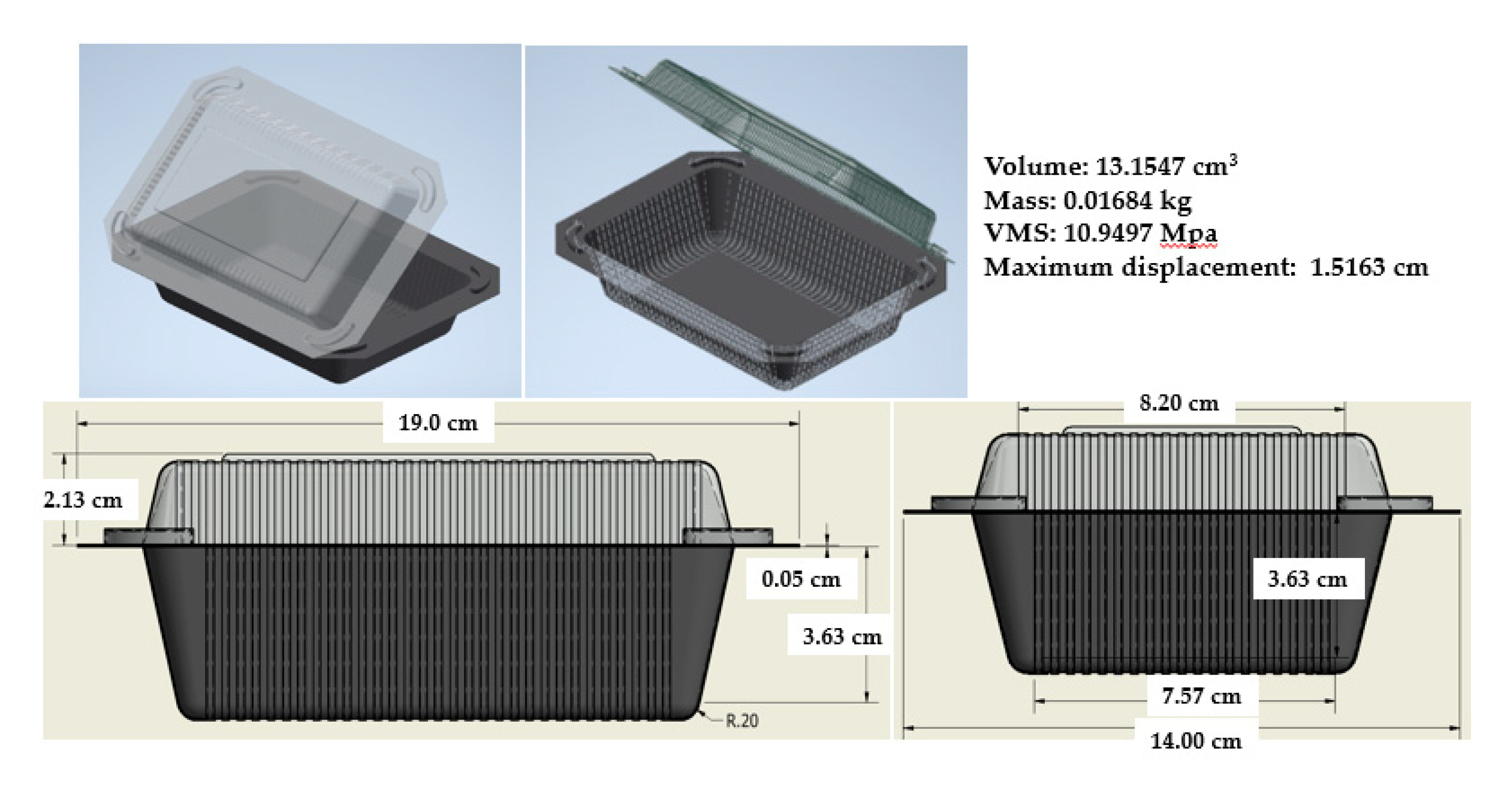
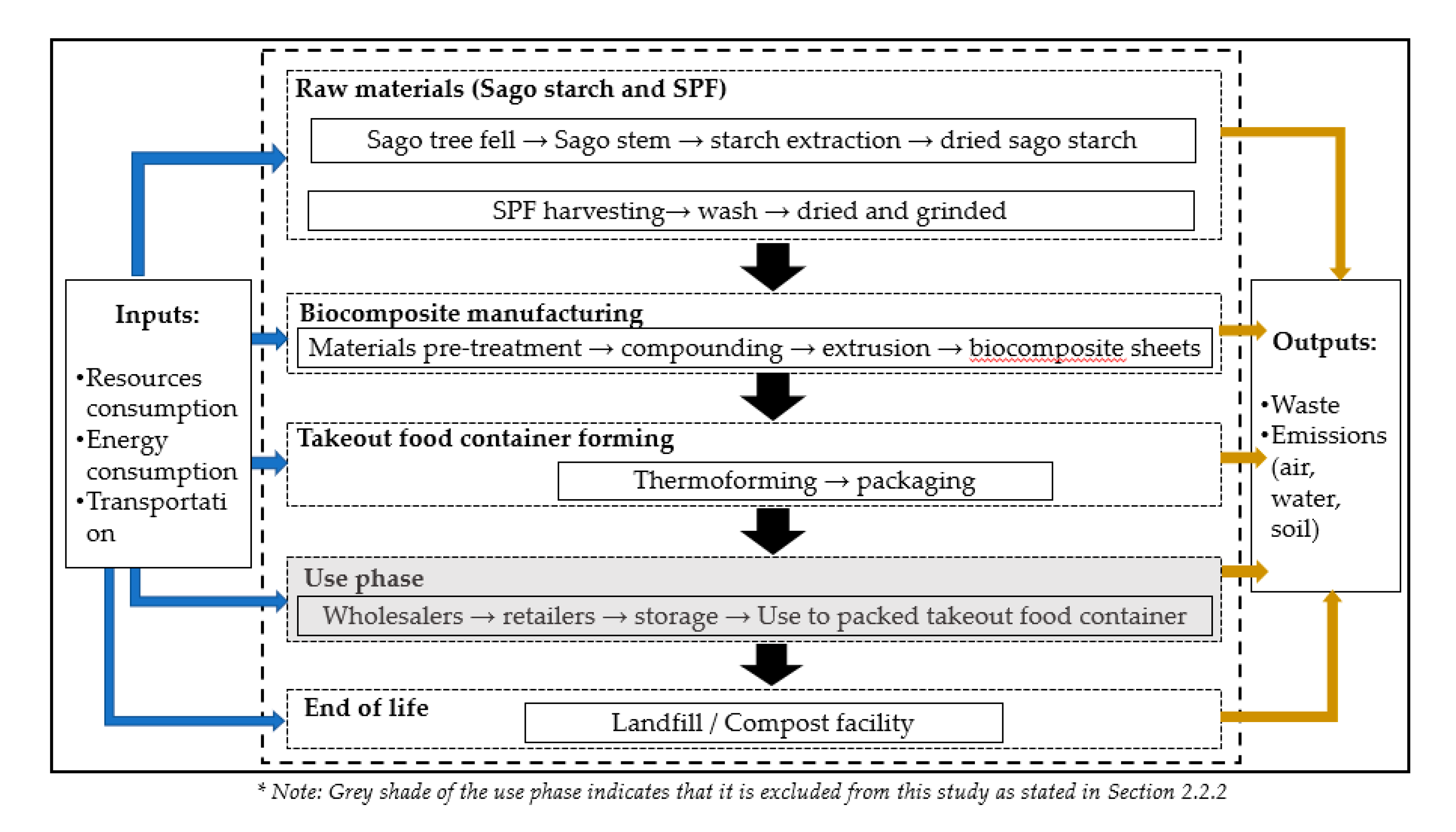
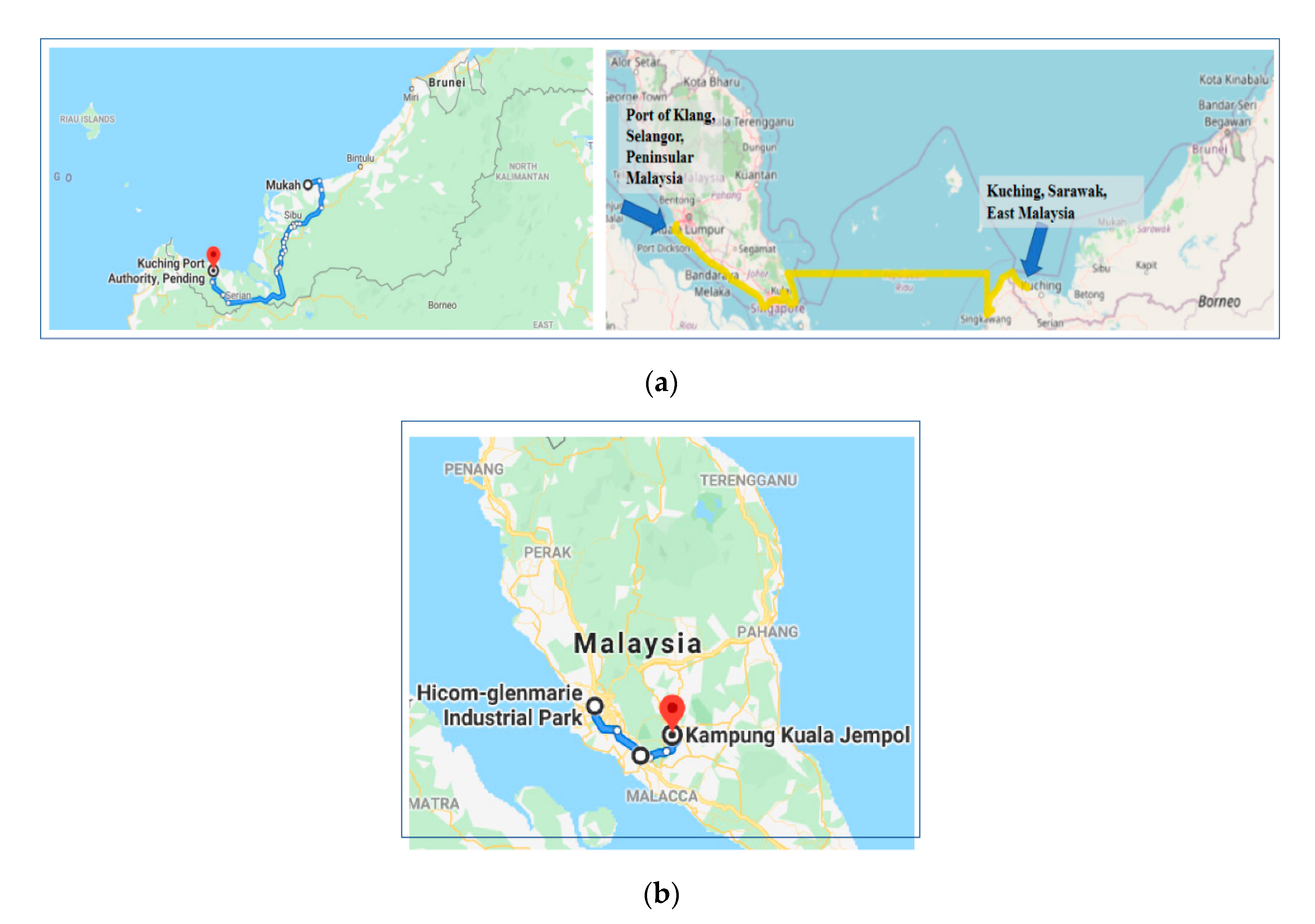
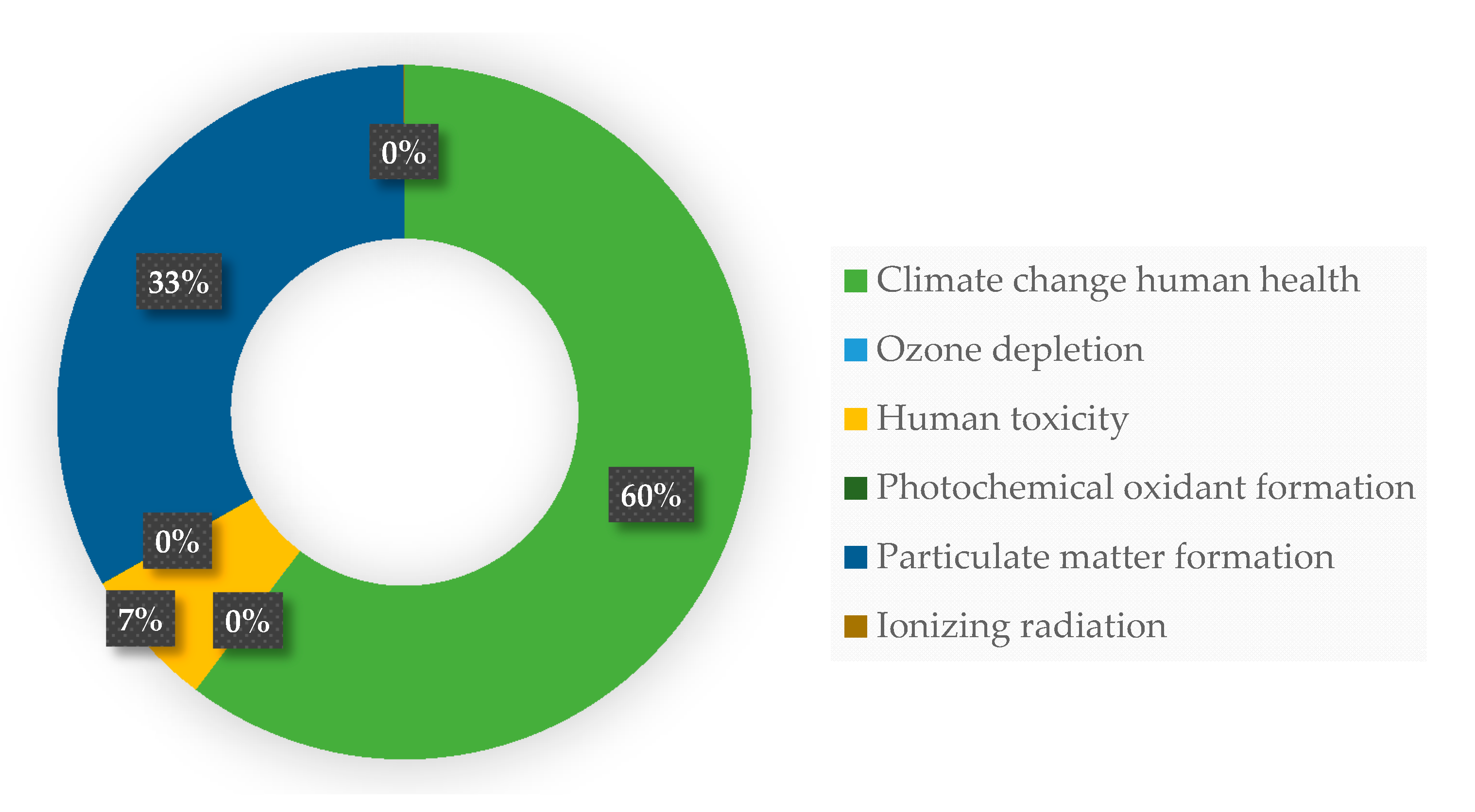
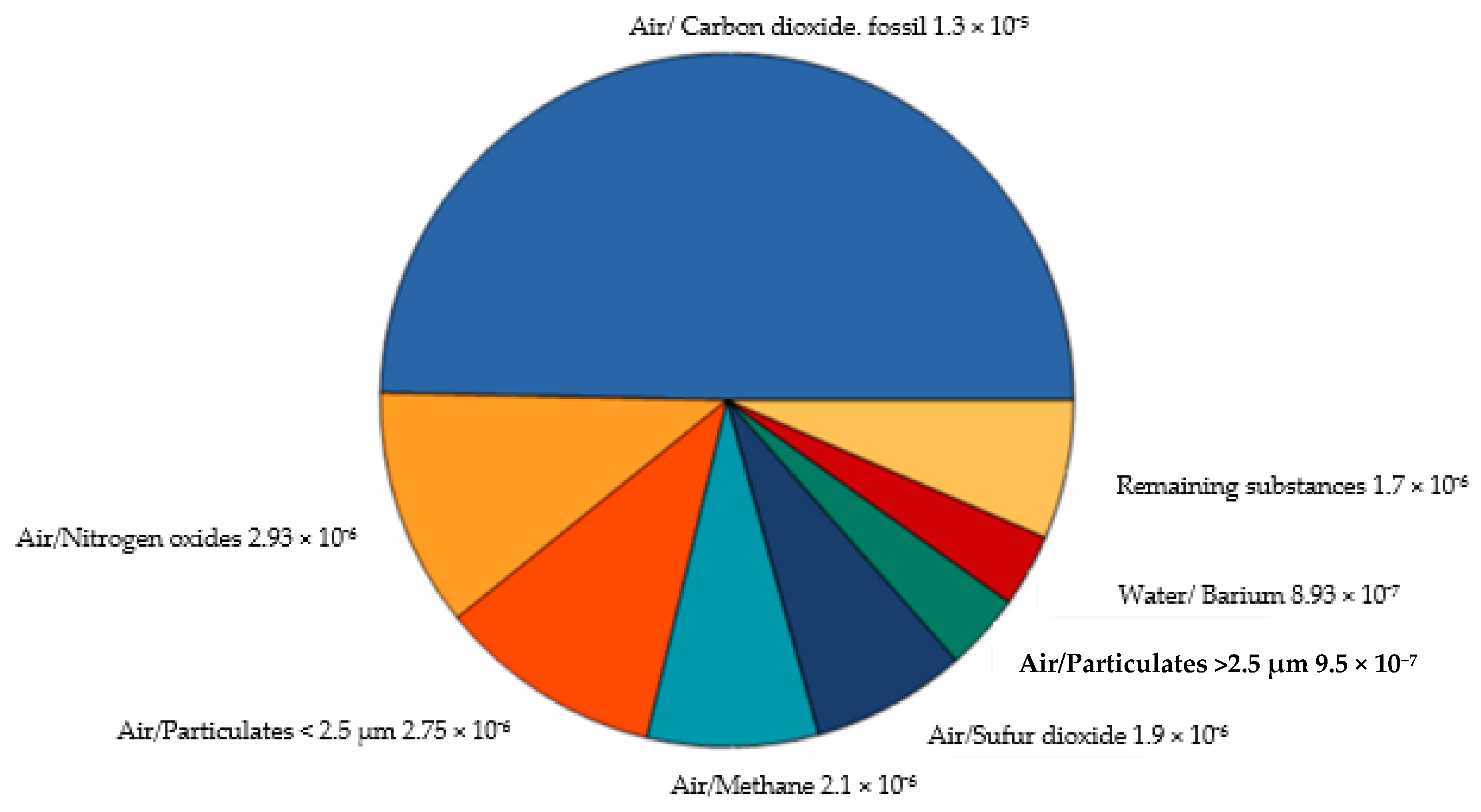

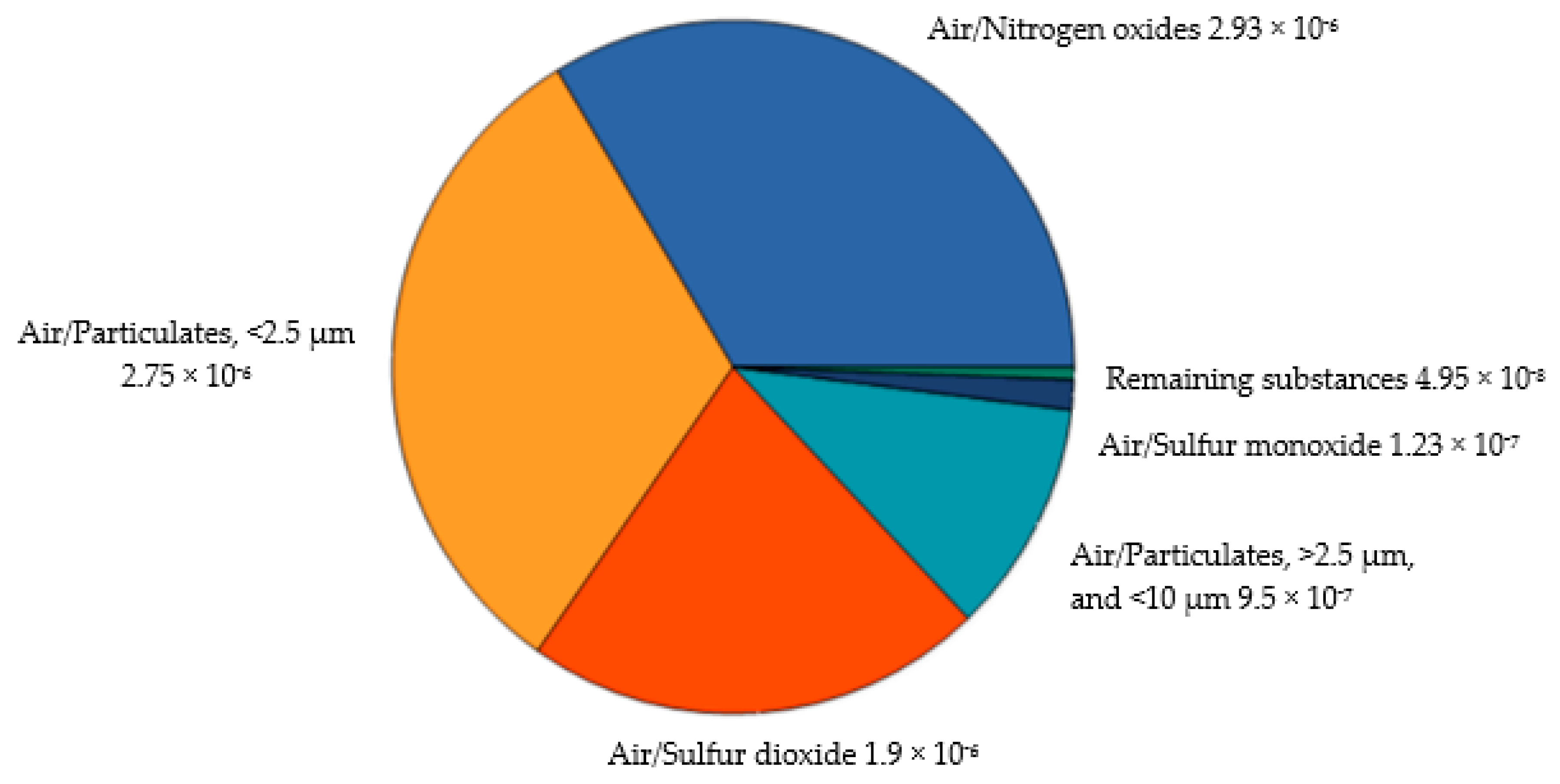
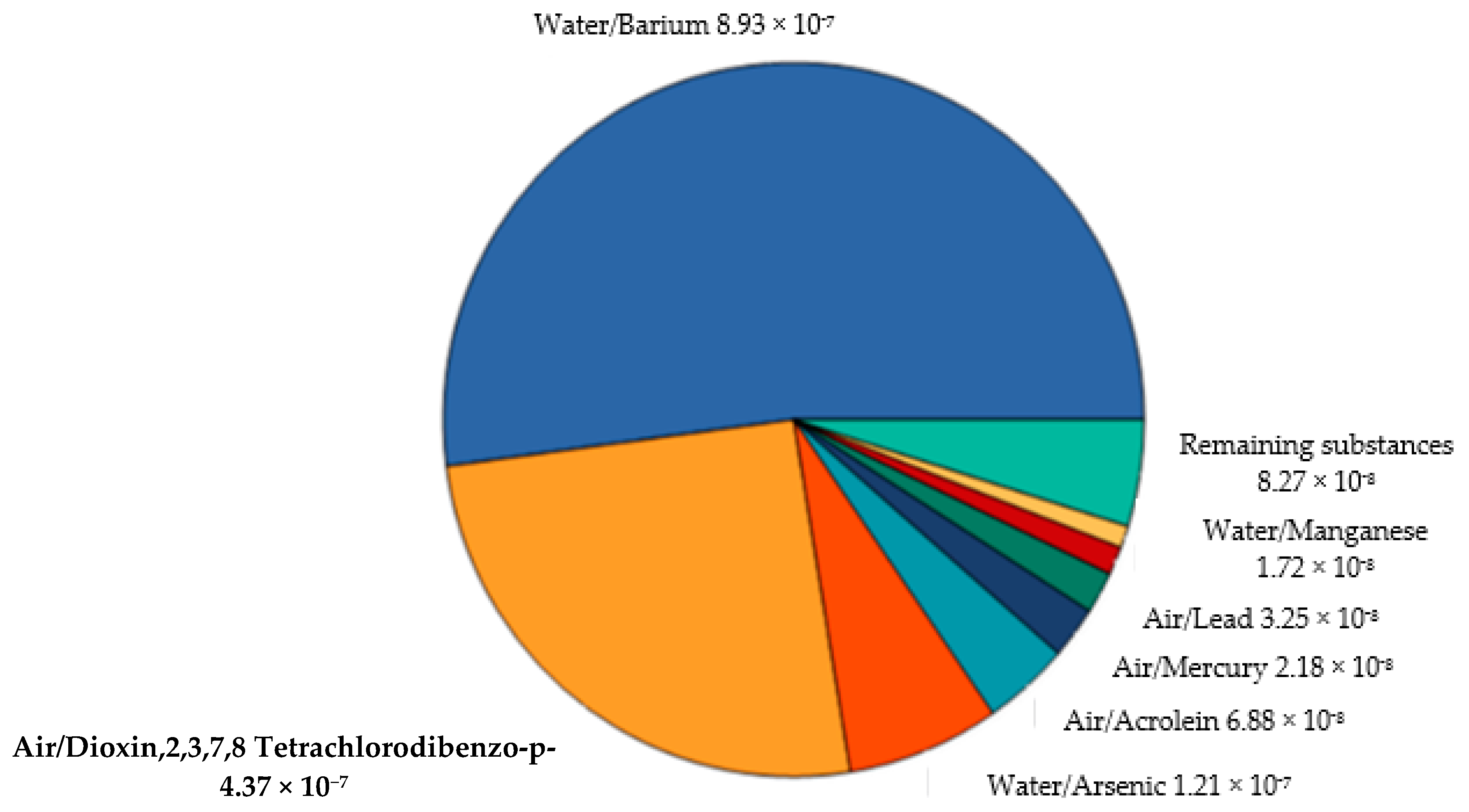
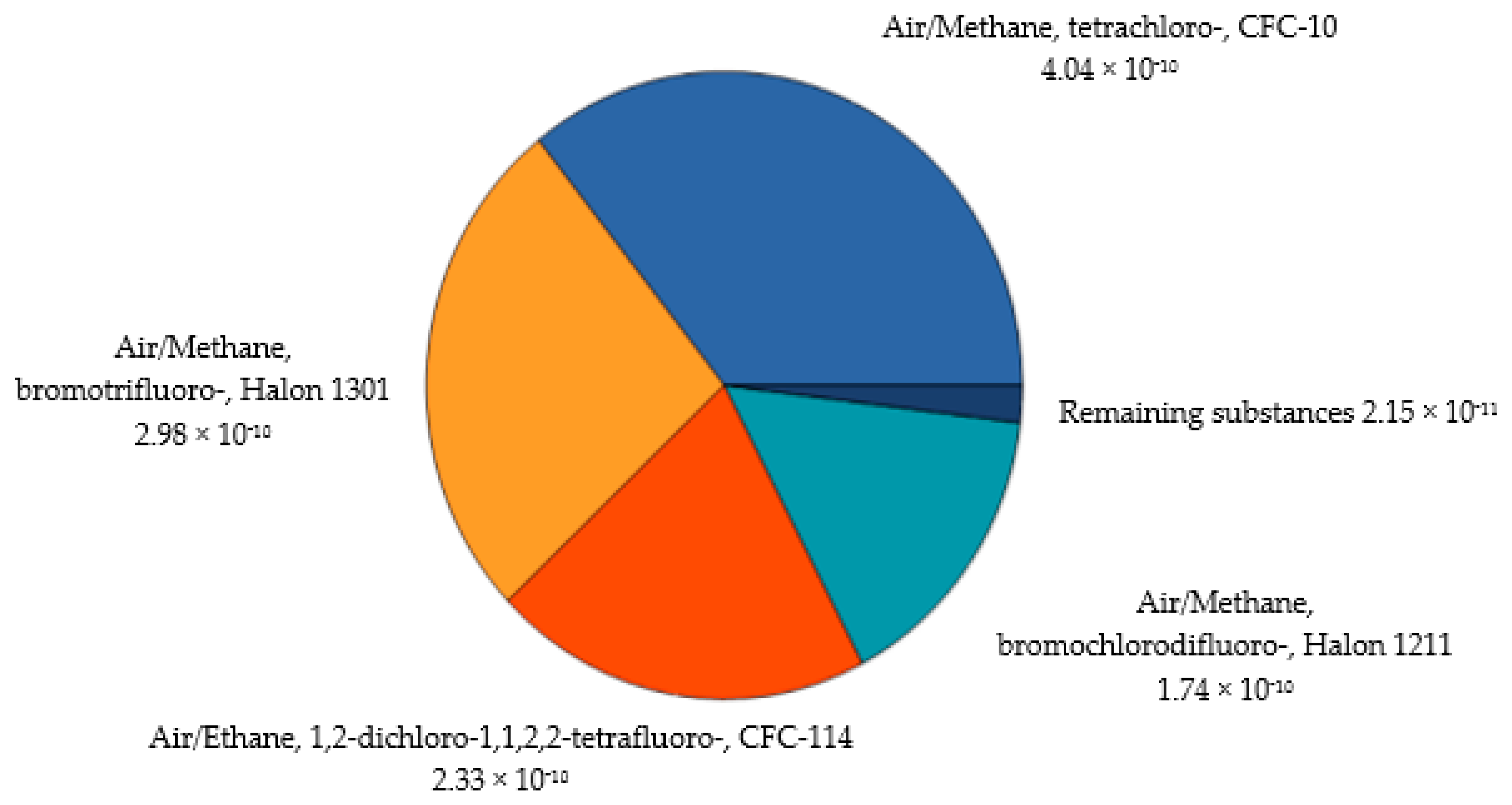
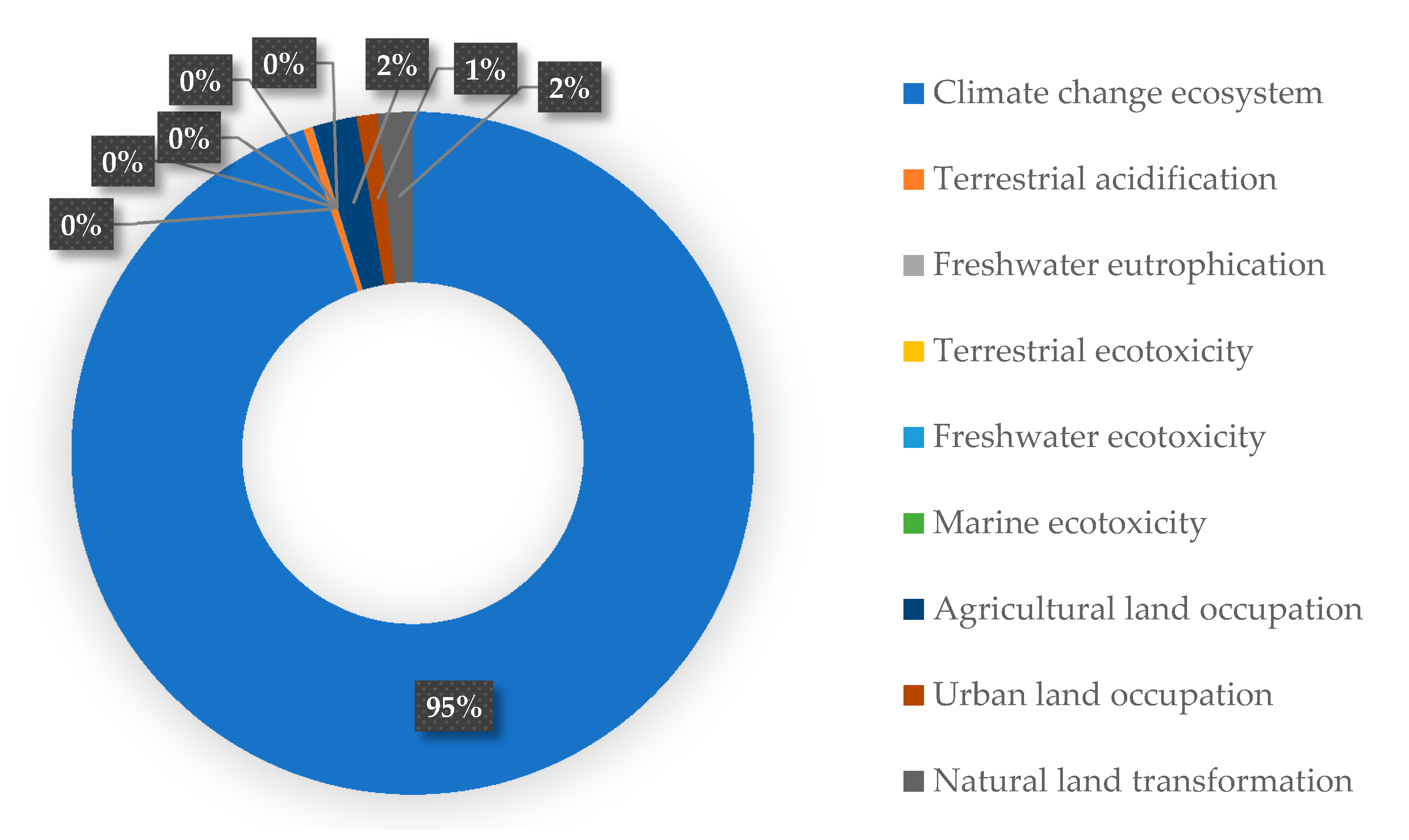
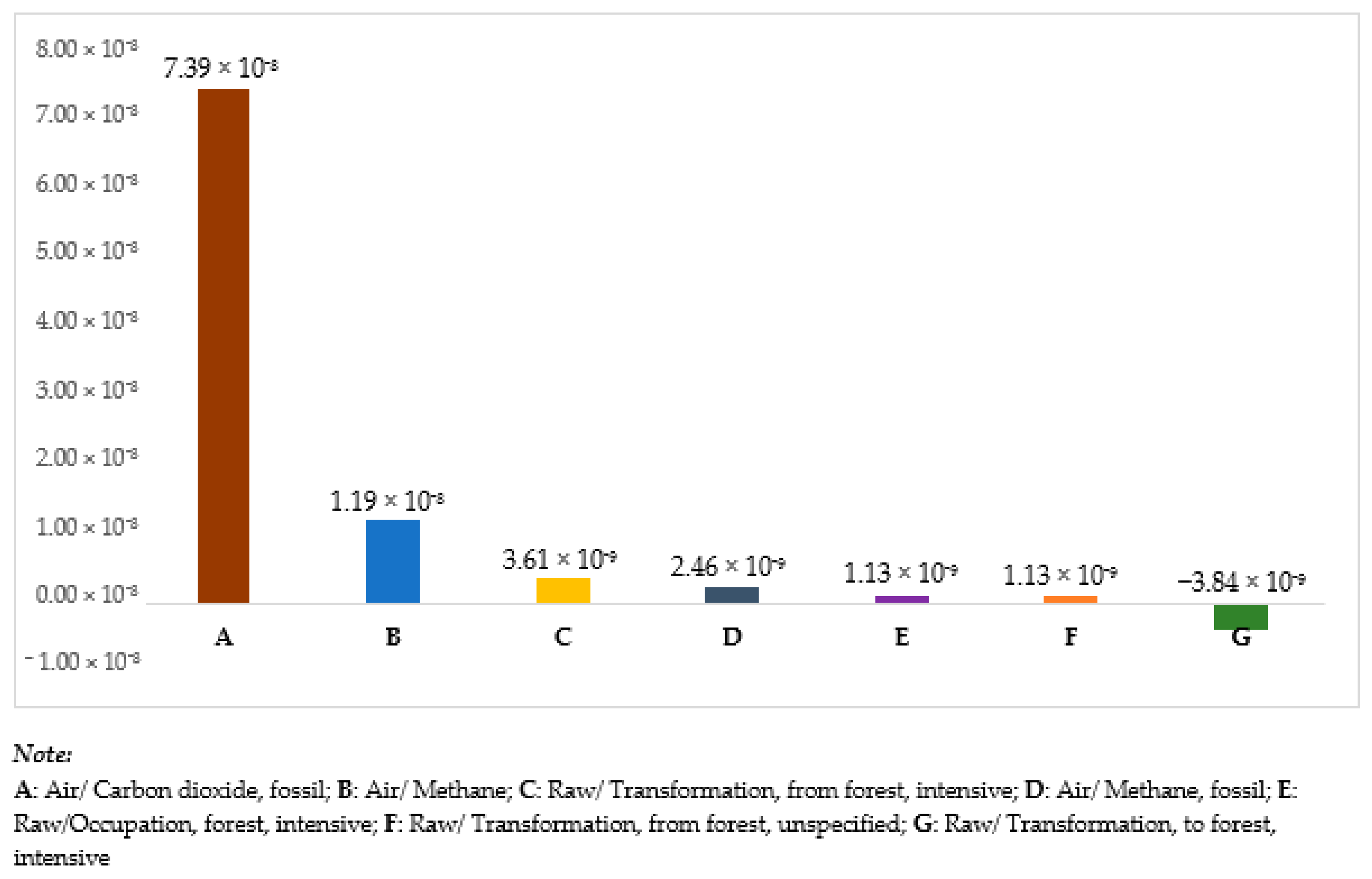
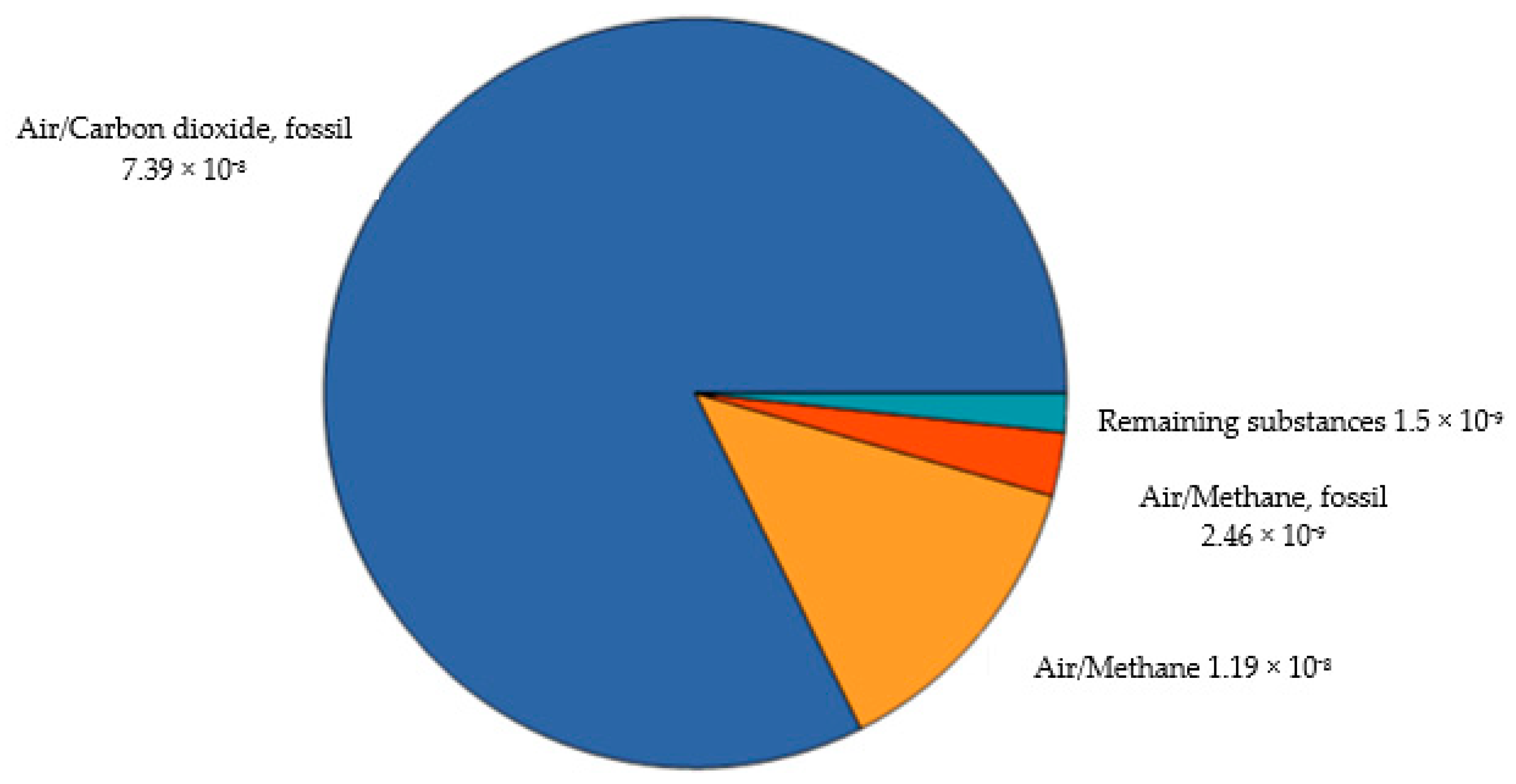
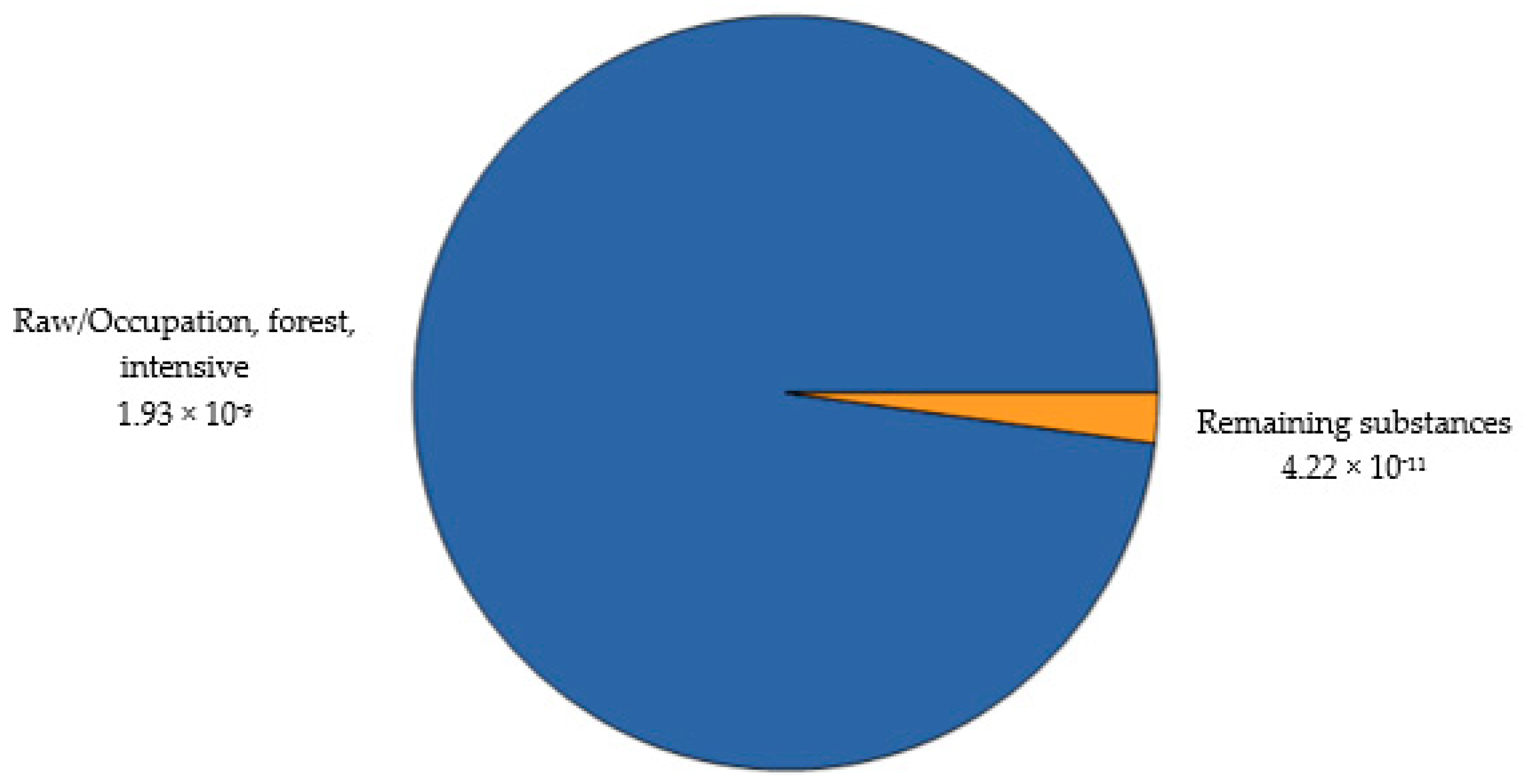
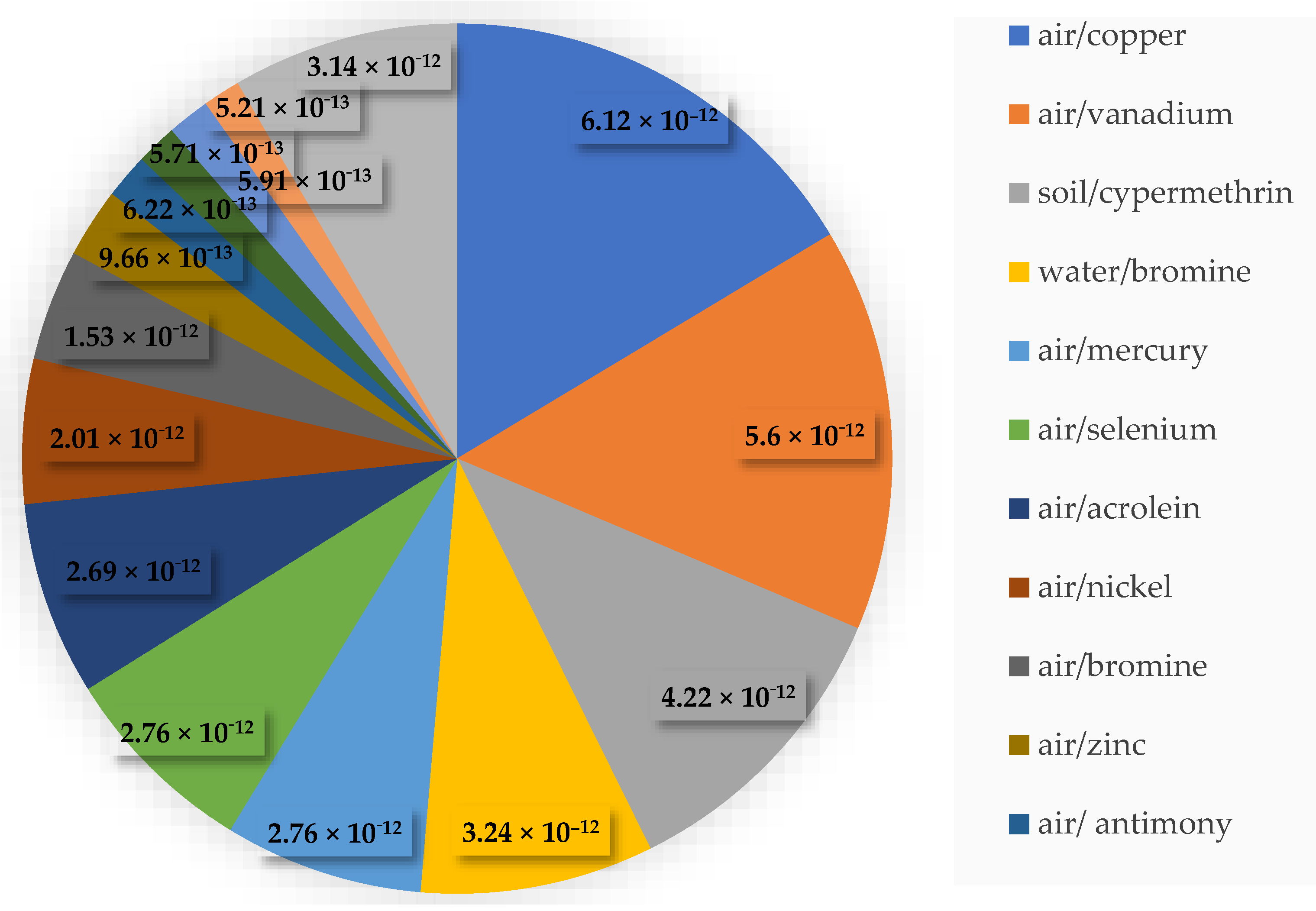
| Parameters | Description | Qty | Unit | Data Sources/References |
|---|---|---|---|---|
| Background data | ||||
| Raw materials—Sago starch | ||||
| Inputs from Nature | ||||
| Standing sago tree | Sago tree felling for sago starch production (9.449 kg for 1 kg sago starch), 70% of 1 kg SPF-reinforced Sago composite | 6.6143 | kg | [23,26,30] and USLCI database |
| Inputs from technosphere—Materials/Fuels | ||||
| Tap Water | Used in sago starch production (3.7 kg used for 1 kg of sago, 70% of 1 kg SPF-reinforced Sago composite) | 2.59 | kg | [23] and Agri-footprint database |
| Glycerol | Plasticizer for sago starch, 30% of 1 kg sago starch, (70%Sago starch content for 1 kg SPF-reinforced Sago composite | 0.21 | kg | [31,32] and USLCI database |
| Transportation | ||||
| Mill to storage | Mill to storage (Mukah-Kuching 463 km, Lorry 16–32 metric ton) per 0.7 kg sago starch, | 0.32411 | tkm | [33] and Ecoinvent 3 database |
| Borneo to Peninsular (Ports) | Ports (Kuching-Klang, 735 nautical miles, waterways freight, barge tanker) 0.7 kg sago starch, | 0.136122 | tkm | [33] and Ecoinvent 3 database |
| Port to plant | Port to Manufacturing, Klang-Shah Alam 35 km, Lorry 16–32 metric ton, 0.7 kg sago starch | 0.0245 | tkm | Ecoinvent 3 database |
| Raw materials—Sugar palm fiber | ||||
| Inputs from technosphere—Materials/Fuels | ||||
| Tap Water | Sugar palm fiber preparation (Assumed 10 kg water used to wash 1 kg sugar palm fiber), 30% SPF content of 1 kg SPF-reinforced Sago composite | 3 | kg | Agri-footprint database |
| Inputs from technosphere—Electricity/Heat | ||||
| Electricity—Sugar palm fiber production | Drying of sugar palm fiber (30% SPF content of 1 kg SPF-reinforced Sago composite) | 0.67 | kWh | Assume similar equipment used as in [25], Ecoinvent 3 database |
| Electricity—Sugar palm fiber production | Grinding of sugar palm fiber (30% SPF content of 1 kg SPF-reinforced Sago composite) | 0.25 | kWh | Assume similar equipment used as in [25], Ecoinvent 3 database |
| Transportation | ||||
| Transportation of sugar palm fiber | Mill to composite manufacture plant (Jempol-Shah Alam, Lorry 16–32 metric ton) (30% SPF content of 1 kg SPF-reinforced Sago composite) | 0.0462 | tkm | [27], Ecoinvent 3 database |
| Biocomposite manufacturing | ||||
| Inputs from technosphere—Electricity/Heat | ||||
| Electricity | Compounding—1 kg of SPF-reinforced Sago biocomposite | 5.59 | kWh | Assume similar equipment used in [25], Ecoinvent 3 database |
| Electricity | Drying of biocomposite | 0.67 | kWh | Assume similar equipment used in [25], Ecoinvent 3 database |
| Electricity | Extrusion and sheet forming | 1.35 | kWh | Ecoinvent 3 database |
| Container forming | ||||
| Inputs from technosphere—Electricity/Heat | ||||
| Electricity—Takeout Food container forming | Thermoforming | 2.9014 | kWh | Ecoinvent 3 database |
| End of life | ||||
| Inputs from technosphere—Materials/Fuels | ||||
| Diesel | Used for the equipment in the composting process, End-of-life: 17% to composting + 83% to landfill | 0.00257 | L | [29] and USLCI database |
| Direct Emissions | ||||
| Ammonia, NH3 | End-of-life: 17% to composting + 83% to landfill | 0.00922 | g | [29], Ecoinvent 3 database |
| Carbon dioxide, CO2 | End-of-life: 17% to composting + 83% to landfill | 0.02007 | kg | [29], Ecoinvent 3 database |
| Methane, CH4 | End-of-life: 17% to composting + 83% to landfill | 0.04953 | kg | [29], Ecoinvent 3 database |
| Nitrogen Oxides, NOx | End-of-life: 17% to composting + 83% to landfill | 0.25225 | g | [29], Ecoinvent 3 database |
| Particulates, PM | End-of-life: 17% to composting + 83% to landfill | 0.00094 | kg | [29], Ecoinvent 3 database |
| Sulfur Oxides, SOx | End-of-life: 17% to composting + 83% to landfill | 0.00003 | g | [29], Ecoinvent 3 database |
| Impact Category (IC) | Unit | Amount |
|---|---|---|
| Human Health Damage | ||
| Climate change human health | DALY | 1.58 × 10−5 |
| Ozone depletion | 0.000113 × 10−5 | |
| Human toxicity | 0.171 × 10−5 | |
| Photochemical oxidant formation | 0.000249 × 10−5 | |
| Particulate matter formation | 0.87 × 10−5 | |
| Ionizing radiation | 0.000824 × 10−5 | |
| TOTAL | 2.63 × 10−5 DALY | |
| Ecosystem Damage | ||
| Climate change ecosystem | species.yr | 8.97 × 10−8 |
| Terrestrial acidification | 0.0399 × 10−8 | |
| Freshwater eutrophication | 0.00296 × 10−8 | |
| Terrestrial ecotoxicity | 0.00382 × 10−8 | |
| Freshwater ecotoxicity | 0.00112 × 10−8 | |
| Marine ecotoxicity | 0.000244 × 10−8 | |
| Agricultural land occupation | 0.197 × 10−8 | |
| Urban land occupation | 0.0925 × 10−8 | |
| Natural land transformation | 0.158 × 10−8 | |
| TOTAL | 9.46 × 10−8 species.yr | |
| Resources scarcity | ||
| Metal depletion | $ | 0.00493 |
| Fossil depletion | $ | 0.486 |
| TOTAL | $0.491 | |
Publisher’s Note: MDPI stays neutral with regard to jurisdictional claims in published maps and institutional affiliations. |
© 2020 by the authors. Licensee MDPI, Basel, Switzerland. This article is an open access article distributed under the terms and conditions of the Creative Commons Attribution (CC BY) license (http://creativecommons.org/licenses/by/4.0/).
Share and Cite
Salwa, H.N.; Sapuan, S.M.; Mastura, M.T.; Zuhri, M.Y.M. Life Cycle Assessment of Sugar Palm Fiber Reinforced-Sago Biopolymer Composite Takeout Food Container. Appl. Sci. 2020, 10, 7951. https://doi.org/10.3390/app10227951
Salwa HN, Sapuan SM, Mastura MT, Zuhri MYM. Life Cycle Assessment of Sugar Palm Fiber Reinforced-Sago Biopolymer Composite Takeout Food Container. Applied Sciences. 2020; 10(22):7951. https://doi.org/10.3390/app10227951
Chicago/Turabian StyleSalwa, H. N., S. M. Sapuan, M. T. Mastura, and M. Y. M. Zuhri. 2020. "Life Cycle Assessment of Sugar Palm Fiber Reinforced-Sago Biopolymer Composite Takeout Food Container" Applied Sciences 10, no. 22: 7951. https://doi.org/10.3390/app10227951
APA StyleSalwa, H. N., Sapuan, S. M., Mastura, M. T., & Zuhri, M. Y. M. (2020). Life Cycle Assessment of Sugar Palm Fiber Reinforced-Sago Biopolymer Composite Takeout Food Container. Applied Sciences, 10(22), 7951. https://doi.org/10.3390/app10227951







